How to Onboard an Azure Enrollment (EA) Subscription
This topic guides you to onboard an Azure Enrollment (EA) Subscription into the platform.
Note:
Before onboarding the Azure Enrollment (EA) subscription, it is mandatory to onboard the Azure Enrollment (EA) parent account in CoreStack. Click here to know about how to onboard an Azure Enrollment (EA) account.
Pre-onboarding
There are certain pre-requisites that needs to be set up in your Azure Enrollment Subscription tenant before it can be onboarded into CoreStack.
CoreStack uses Daemon Application scenario with Client Credentials flow for OAut2.0 flow and grant type as depicted here. Client Credential flow requires a valid Application registration to be created for a specific Azure Enrollment subscription. This will successfully allow access to the required Azure resources.
To onboard your Azure Enrollment subscriptions into CoreStack, the following values must be generated/copied from your Azure console and configured in CoreStack:
- Tenant ID
- Application ID
- Application Secret
As you retrieve each of these values, keep them ready in a notepad to be able to copy and paste into CoreStack while onboarding.
Step-1: Fetch Application ID and Tenant ID
- On the Azure Portal, navigate to Azure Active Directory > App registrations > New registration. The Register an application screen appears.
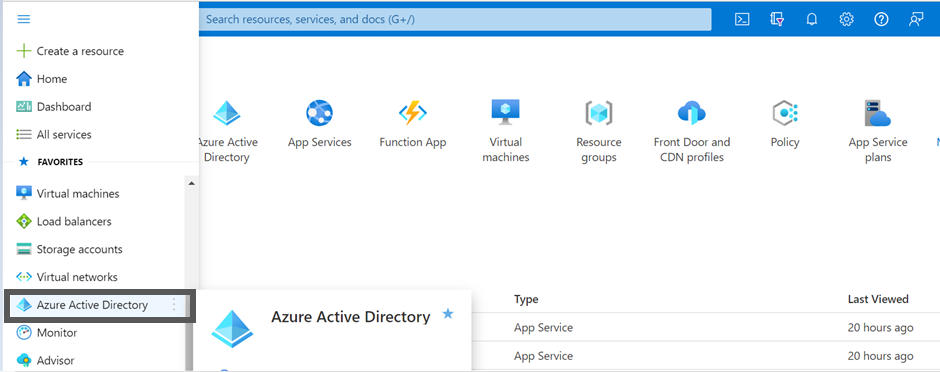
- On the left pane, click App registration and click + New registration.

- In the Name box, type a name for the application, for example, CoreStack.App.
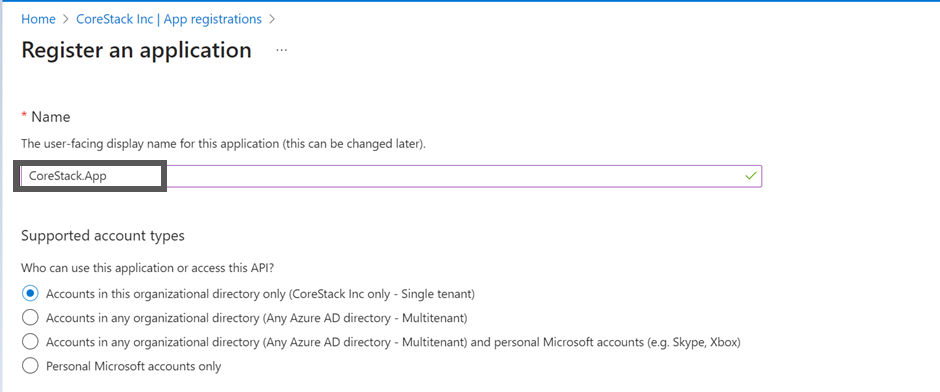
The other fields can be left with the default options.
- The value of the Supported account types field can be Single Tenant.
- The value of the Redirect URI field can be blank.
- Click Register.
The application will be registered, and the Application (client) ID and Directory (tenant) ID will be displayed on the Overview screen. Copy the Application ID and the Tenant ID and paste the details in a notepad.
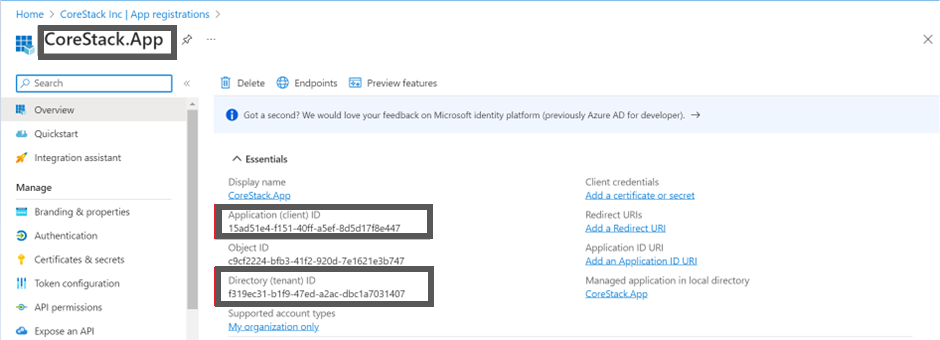
Step-2: Fetch Application Secret
Application Secret is the password or key that you need to provide for the specific app that was just created.
- On the Overview screen, click Certificates & secrets.
- Click + New client secret.
- Provide a description and expiry duration for the secret. You can leave the duration with the default value of 1 year. You can revoke this anytime later, if required.
- Click Add. The Client secret will be created and displayed.
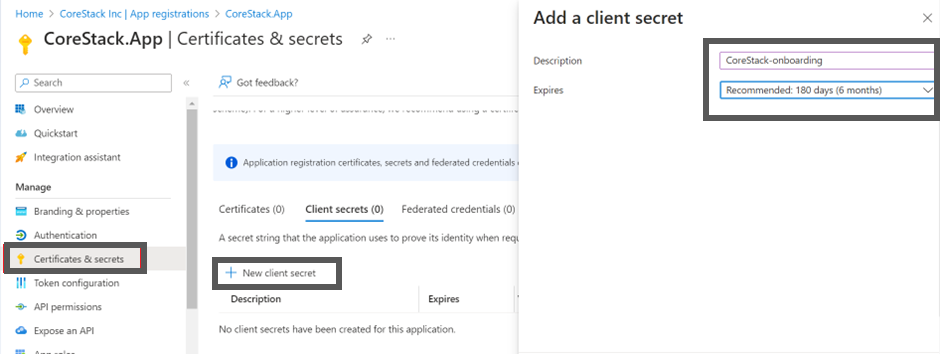
Note:
Ensure that you copy this secret value and paste it in a notepad, since you cannot retrieve this later.
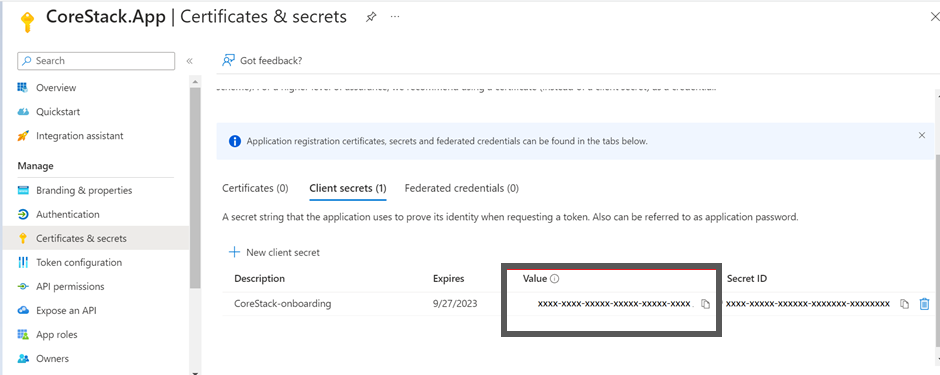
Step-3: IAM Access for App
The app that is created in Step-1 must have the required access within the subscription. To provide the access, follow the below steps:
-
On the Azure Portal, navigate to Subscriptions .
-
Click Access Control (IAM).
-
Click + Add and then click to select Add role assignment. The Add role assignment screen appears.

- Select Job function roles for Assessment Only.

- Select the Reader role for Assessment Only.

- Select the privileged administrator roles for Assessment + Governance.

- Select Contributor for Assessment + Governance.
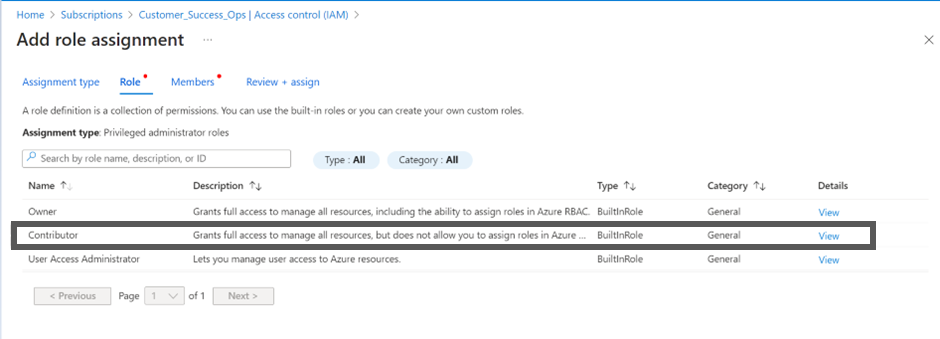
- Select job function roles for Assessment + Governance.

- Select the Resource Policy Contributor for Assessment + Governance.

-
In the Assign access to field, ensure that the User, group, or service principal option is selected.
-
Click + Select members and in the Select field, search and select the app that was created earlier. In this example, select CoreStack.App.

- Click the Save button to assign the role.
After the role is assigned, it will be listed in the Role Assignments tab.
Note:
The "Resource Policy Contributor" role assignment is required only if you intend to use CoreStack to create policies for your Azure subscription.
Step-4: Reservation Reader Role
Note:
You can skip this step if you don’t have any reserved instances in your subscription.
Note:
Be sure to update the Reservation Reader role that will be required for assigning roles to tenants. Perform the following steps to update the Reservation Reader role:
Navigate to Microsoft Enterprise ID > Properties in Azure.
In the Access Management for Azure resources field, toggle the button to enable it.
After enabling it, log out from the Azure portal and log back in to ensure that the changes are reflected.
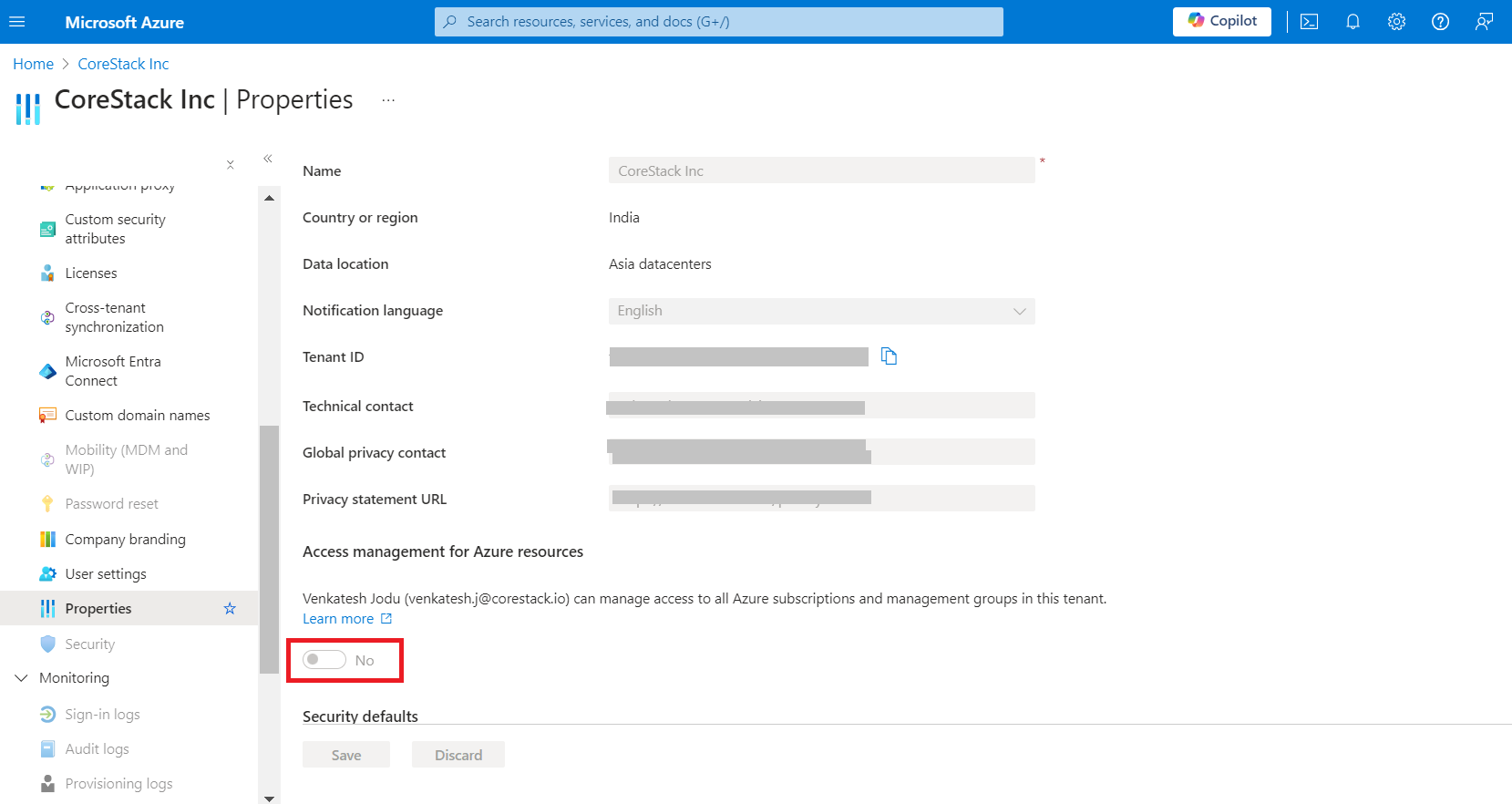
The platform requires Reservation Reader role for CoreStack.App to fetch the reserved instances in the subscription.
- Navigate to Virtual machines > Reservations > View.

You can now see all the reserved instances in your subscription.
- Click Role Assignment.
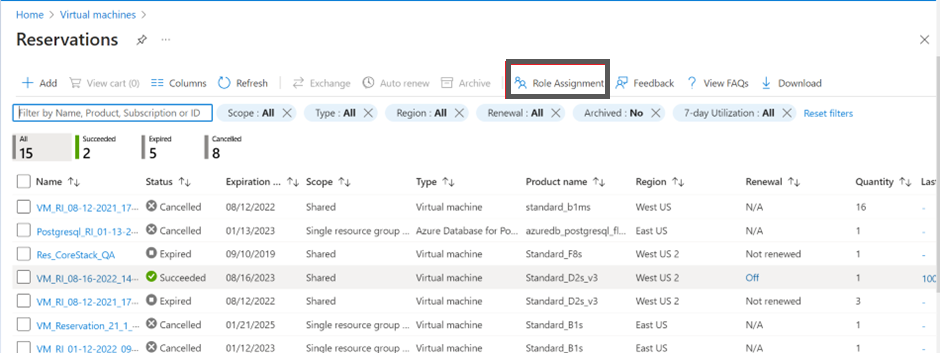
- Click +Add and then click Add role assignment.

- In the Assignment type field, select Job function roles.

- In the Search box, type Reservations Reader and select it from the search result and then click Next.

-
Ensure that the User, group, or service principal option is selected in the Assign access to field.
-
Search and select the app that was created earlier. In this example, select CoreStack.App in the Select field.
-
Click Save button to assign the role.
Copy all these details and provide them while onboarding your Azure Subscription into CoreStack.
Account Onboarding Using PowerShell Script
Overview
Users can utilize a PowerShell script that simplifies the process of onboarding new accounts into the platform by automating several critical steps. This allows for an efficient and error-free operation, ensuring that all required components are properly configured without the need for any manual intervention.
The steps involved in the onboarding process are:
- Selecting Azure Subscriptions
- Assigning roles
- Creating a service principal
- Registering the necessary resource providers
Prerequisites
Before going ahead with the automated process of onboarding Azure accounts, users must check for the following prerequisite conditions.
- First, check whether the Azure PowerShell module is installed. Run the command below to check for the Azure PowerShell module.
Get-Module -Name Az -ListAvailable- If Azure PowerShell module is not installed, then install it by running:
Install-Module -Name Az -AllowClobber -Scope CurrentUser Import-Module Az - Next, run the command below to check whether AzureAD module is installed.
Get-Module -Name AzureAD -ListAvailable- If AzureAD module is not listed, then install it by running:
Install-Module -Name AzureAD -AllowClobber -Scope CurrentUser Import-Module AzureAD - Users must have the appropriate permissions (i.e. Owner-level access in Subscription) to create applications and assign roles in Azure.
Script Description
The PowerShell script performs the following main tasks:
- Create a Service Principal: Facilitates the creation of a new service principal in Azure AD with a display name provided by the user.
- Select Azure Subscriptions: Allows the user to select one or multiple Azure Subscriptions or choose all enabled Subscriptions.
- Assign Roles to Service Principal: Assigns the selected roles (like Reader, Contributor, etc.) to the service principal across chosen Subscriptions.
- Register Azure Resource Providers: Registers a predefined list of Azure resource providers necessary for operations in the platform.
Refer to the PowerShell script below that can be used for onboarding.
# Function to create Service Principal and generate a secret
Connect-AzureAD
function Create-ServicePrincipal {
$displayName = Read-Host "Please enter a display name for the new Service Principal"
if ([string]::IsNullOrWhiteSpace($displayName)) {
Write-Host "No display name provided. Exiting function."
return $null
}
try {
$application = New-AzureADApplication -DisplayName $displayName
Write-Host "Application created with ID: $($application.AppId)"
$servicePrincipal = New-AzureADServicePrincipal -AppId $application.AppId
Write-Host "Service Principal created with Application ID: $($application.AppId)"
$startDate = Get-Date
$endDate = $startDate.AddYears(1)
$passwordCredential = New-AzureADApplicationPasswordCredential -ObjectId
$application.ObjectId -CustomKeyIdentifier "Access" -StartDate $startDate -EndDate $endDate
Write-Host "Secret created for Application. Value: $($passwordCredential.Value)"
# Fetch tenant ID
$tenantId = (Get-AzureADTenantDetail).ObjectId
Write-Host "Tenant ID: $tenantId"
return $application, $servicePrincipal, $passwordCredential, $tenantId
} catch {
Write-Host "Failed to create service principal or secret: $_"
return $null
}
}
# Example of calling the function
$application, $servicePrincipal, $secret, $tenantId = Create-ServicePrincipal
Start-Sleep -Seconds 10
# Function to list and select the subscriptions
function Select-Subscription {
param (
[string]$title,
[array]$subscriptions
)
Write-Host $title
for ($i = 0; $i -lt $subscriptions.Count; $i++) {
Write-Host "$($i+1) : $($subscriptions[$i].name) - $($subscriptions[$i].id)"
}
# Adding an option for selecting all subscriptions
Write-Host "$($subscriptions.Count + 1) : All Subscriptions"
$indices = Read-Host "Enter the indices of the subscriptions (comma separated, or select 'All'):"
# Check if the user selected "All"
if ($indices -eq $($subscriptions.Count + 1)) {
return $subscriptions
}
else {
$selectedIndices = $indices -split ',' | ForEach-Object { [int]$_ - 1 }
$selectedSubscriptions = $selectedIndices | ForEach-Object { $subscriptions[$_] }
return $selectedSubscriptions
}
}
# Assuming $subs is a JSON string from the output of `az account list`
$subs = az account list --query "[?state=='Enabled']" --only-show-errors
$subs_ids = $subs | ConvertFrom-Json
$selectedSubscription = Select-Subscription -title "Please select a subscription:" -subscriptions $subs_ids
# Displaying the selected subscriptions
foreach ($sub in $selectedSubscription) {
Write-Host "Selected subscription: $($sub.name) - $($sub.id)"
}
$selectedSubscription | Format-Table -Property Name, Id, State, IsDefault -AutoSize
# Function to define the roles
function Show-Menu {
param (
[string]$title,
[hashtable]$menuItems,
[bool]$allowMultiple = $false
)
Write-Host "`n$title"
$menuItems.Keys | Sort-Object | ForEach-Object { Write-Host "$_ : $($menuItems[$_])" }
if ($allowMultiple) {
$input = Read-Host "Enter choices separated by commas (e.g., 1,2)"
$choices = $input -split ',' | ForEach-Object { $_.Trim() }
} else {
$choices = @(Read-Host "Enter choice")
}
$selectedItems = $choices | ForEach-Object { $menuItems[$_] }
return $selectedItems
}
# Define the possible role definitions in a hashtable
$roleDefinitions = @{
"1" = "Reader"
"2" = "Contributor"
"3" = "Resource Policy Contributor"
}
# Display menu and get user choices
$selectedRoles = Show-Menu -title "Select Role Definitions" -menuItems $roleDefinitions -allowMultiple $true
# Display the selected roles
$selectedRoles | ForEach-Object { Write-Host "- $\_" }
# Assining the role to the selected subscriptions
foreach ($sub in $selectedSubscription) {
$context = Set-AzContext -SubscriptionId $sub.id -ErrorAction SilentlyContinue
if ($context) {
Write-Host "Switched to subscription: $($sub.name)"
# Assign each selected role to the service principal for the subscription
foreach ($role in $selectedRoles) {
try {
# Make sure to use ServicePrincipal ObjectId
$roleAssignment = New-AzRoleAssignment -ObjectId $servicePrincipal.ObjectId -RoleDefinitionName $role -Scope "/subscriptions/$($sub.id)" -ErrorAction Stop
Write-Host "Successfully assigned $role to service principal $($servicePrincipal.AppId) in subscription $($sub.name)"
} catch {
Write-Host "Failed to assign $role to service principal $($servicePrincipal.AppId) in subscription $($sub.name): $_"
}
}
}
}
# Registering the Mandatory Resources Providers for the selected subscription/subscriptions
$resourceProviders = @(
"Microsoft.Authorization",
"Microsoft.Billing",
"Microsoft.Commerce",
"Microsoft.Consumption",
"Microsoft.CostManagement",
"Microsoft.Insights",
"Microsoft.Network",
"Microsoft.PolicyInsights",
"Microsoft.Security",
"Microsoft.Compute",
"Microsoft.ContainerInstance",
"Microsoft.ContainerRegistry",
"Microsoft.ContainerService",
"Microsoft.DBforMySQL",
"Microsoft.DBforPostgreSQL",
"Microsoft.DevTestLab",
"Microsoft.RecoveryServices",
"Microsoft.SQL",
"Microsoft.Storage",
"Microsoft.Web"
)
foreach ($sub in $selectedSubscription) {
# Set the Azure context to the current subscription in the loop
$context = Set-AzContext -SubscriptionId $sub.id -ErrorAction SilentlyContinue
# Pause after setting the context to ensure it has been applied
Start-Sleep -Seconds 10
if ($context) {
Write-Host "Switched to subscription: $($sub.name)"
# Now perform actions on the current subscription
foreach ($provider in $resourceProviders) {
try {
$status = Get-AzResourceProvider -ProviderNamespace $provider
if ($status.RegistrationState -eq "Registered") {
Write-Host "Resource provider $provider is already registered in $($sub.name)."
} else {
Register-AzResourceProvider -ProviderNamespace $provider | Out-Null
Write-Host "Registered resource provider: $provider in $($sub.name)"
# Wait after registering a provider to ensure the operation completes
Start-Sleep -Seconds 20
}
} catch {
Write-Host "Failed to retrieve or register the resource provider $provider in $($sub.name). Error: $_"
}
}
} else {
Write-Host "Failed to set context to subscription: $($sub.name)"
}
}
exit-PSSession
Onboarding Steps
Perform the following steps to complete the onboarding process for Azure cloud accounts using the PowerShell script:
-
To create a service principal, when prompted, enter a display name for a new Azure AD application and service principal.
The script creates the application and service principal, and generates a secret key valid for one year. You can view the tenant ID, application ID, and secret value (Note: We strongly recommend copying these values down in a notepad).
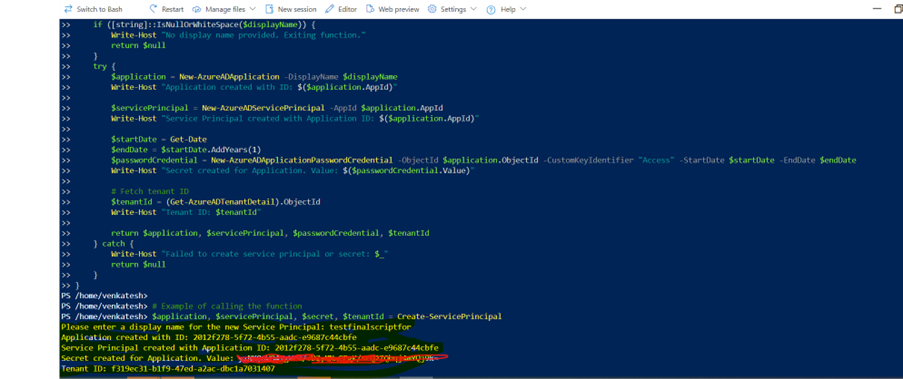
-
When prompted, enter the indices of the Azure subscription account(s) for onboarding separated by commas, or choose all subscriptions by entering a special index.
-
When prompted, select one or more roles to assign to the service principal. It then assigns the selected roles to the service principal for each chosen Subscription.
-
The script automatically attempts to register a set of required Azure resource providers if they are not already registered.
Error Handling:
The script includes error handling to provide feedback if any operation(s) fail, such as role assignments or resource provider registration.
Onboarding an Azure Enrollment (EA) Subscription
The following steps need to be performed to onboard an Azure Subscription:
- Sign-in to the CoreStack application.
- On the CoreStack dashboard, click Add New, select Single Account, and then click Start Now. The onboarding screen appears.
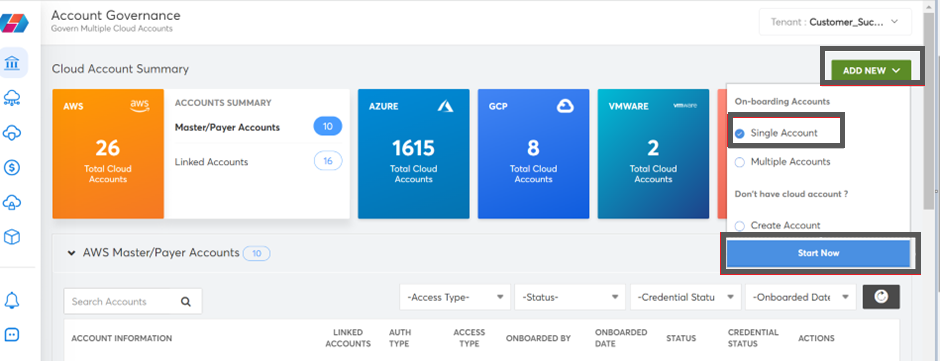
- In the Public Cloud field, select Azure and click Get Started.
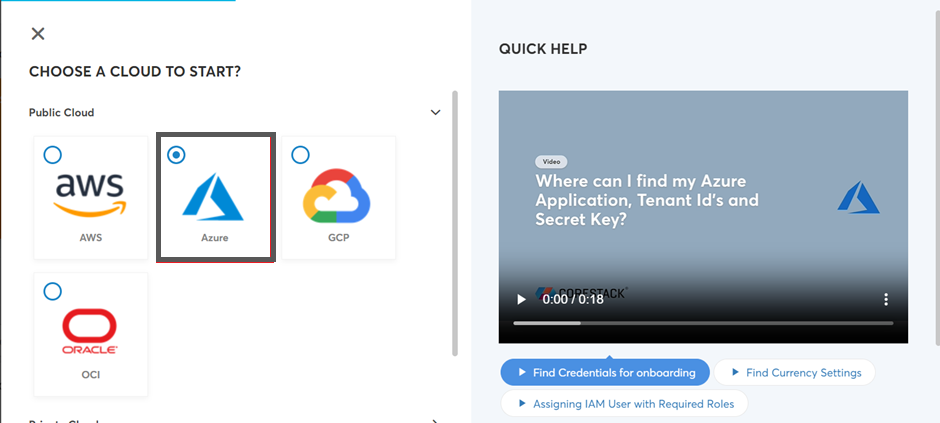
- In the Access Type field, select the required option. The options are: Assessment and Assessment + Governance.
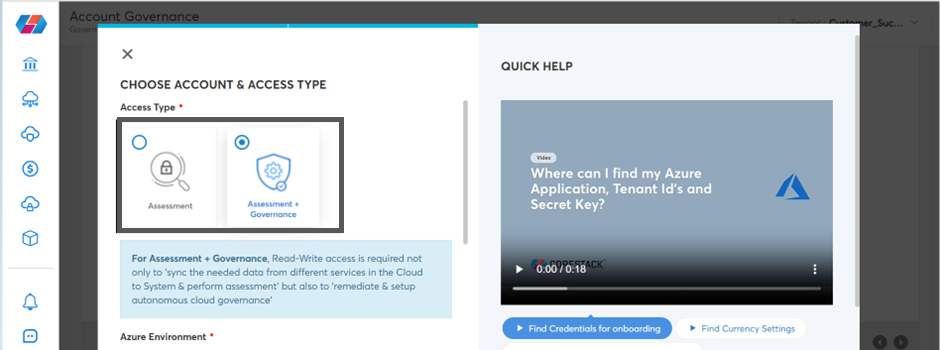
- In the Azure Environment field, select the required option. The options are: Azure Global, Azure China, and Azure Government.
- In the Currency dropdown list, click to select the required currency.
- In the Environment dropdown list, click to select the appropriate option. The options are: Production, Staging, QA, and Development.
- Click Next.
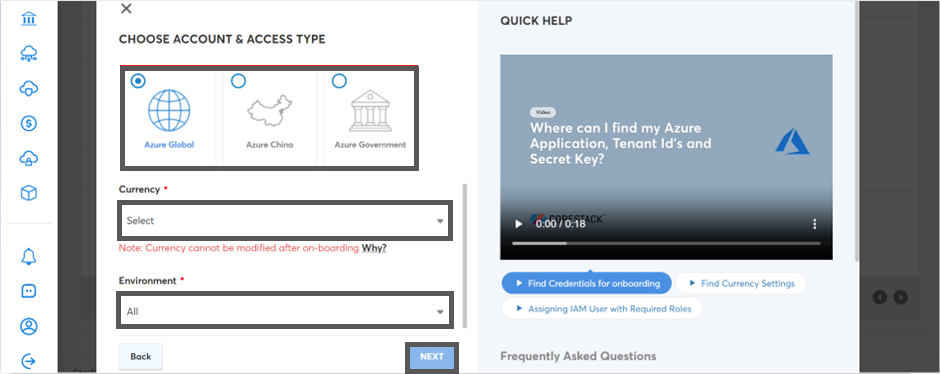
- Provide the details for other fields (Tenant ID, Application ID, Application Secret) as explained in the Pre-onboarding section.
- Click Validate.
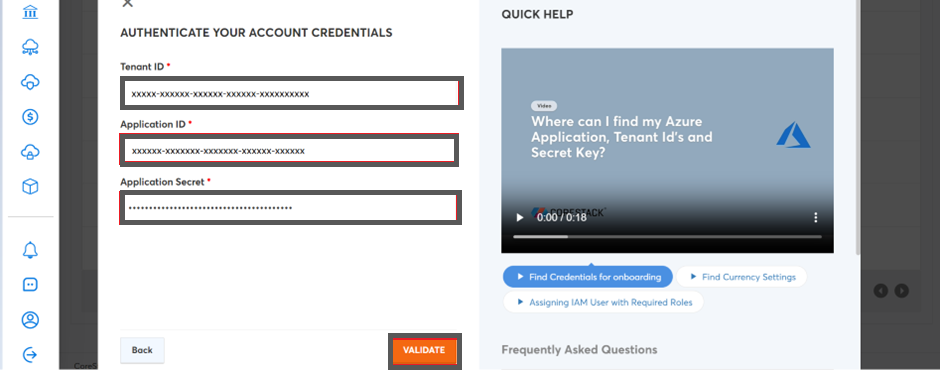
The Advanced Settings section will be displayed with additional fields (Name, Subscription, Subscription Type, Parent Account, and Scope).
- In the Name field, modify the pre-populated name of the account, if required.
- In the Subscription dropdown list, select the required subscription.
- In the Subscription Type field, select the Enterprise option.
- In the Scope field, select the required option. The options are: Account, Private, and Tenant.
- Click List Parent Account and select the parent account.
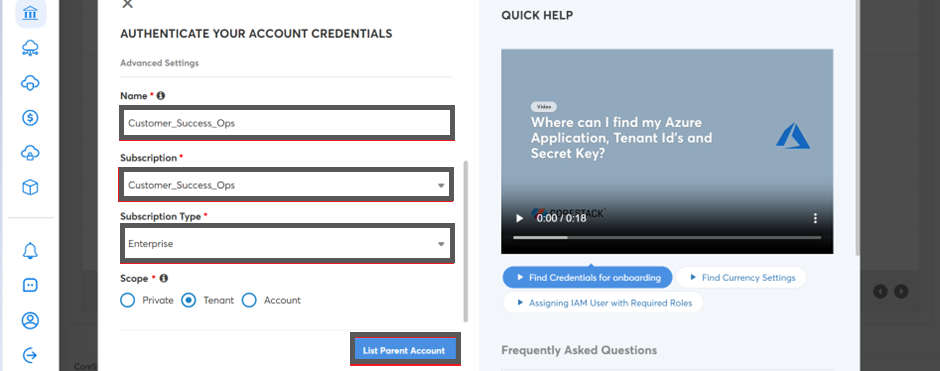
- Click I’m Done.

The Azure Subscription will be onboarded successfully into CoreStack. Relevant insights and information about the resources available in the account will be populated under each cloud governance pillars in CoreStack.
Why are these Permissions Required?
CoreStack requires Contributor access to the following Service Providers. However, the account owner can restrict access to specific services that will only be managed through CoreStack.
Following table explains the need for access to the service with the rationale:
| Azure Provider | Product/Category | Reader Access (For Discovery) | Contributor Access (For Actions) |
|---|---|---|---|
| Microsoft.Compute | Virtual Machines Virtual Machines Scale Sets Virtual Machines Sizes Availability Sets Image Publishers Images Disks | Mandatory | Mandatory |
| Microsoft.ContainerInstance | Container Groups | Preferred | Optional |
| Microsoft.ContainerRegistry | Container Registry | Preferred | Optional |
| Microsoft.ContainerService | Container Service Kubernetes | Preferred | Optional |
| Microsoft.Storage | Storage accounts Storage Snapshots | Mandatory | Mandatory |
| Microsoft.RecoveryServices | Recovery Vault | Preferred | Optional |
| Microsoft.Network | Route Tables Network Security Group Virtual Networks Public IP Address Traffic Manager Profiles Load Balancer Express Routes Application Gateway Application Gateway Available SSL Policy | Mandatory | Mandatory |
| Microsoft.Sql | SQL | Preferred | Optional |
| Microsoft.DBforPostgreSQL | PGSQL | Preferred | Optional |
| Microsoft.DBforMySQL | Mysql | Preferred | Optional |
- Preferable: Access is not mandatory. However, some of the automation features will not be functional without the required access. You can exclude them for “Assessment-Only”.
- Optional: Not mandatory, similar to that of Preferable, core features will continue to work. Some low-level actions will have an Impact. You can exclude them for “Assessment-Only”.
- Mandatory: Non-negotiable, even to onboard account with read-only permissions (“Assessment-Only”), these access details would be needed.
Impact on the Azure Subscription
If you intend to use CoreStack for remediation and automation, CoreStack creates resources and applies some configurations in Azure while configuring these capabilities in CoreStack.
Alert Rules and Alert Actions
Alert rules will be created when monitoring thresholds configured as part of the Operations – Alerts module.
A new alert action will be added to the created rules to invoke CoreStack notification webhook when threshold alert is triggered.
Azure Policy
CoreStack will create the Policy Definitions and Assignments based on the GuardRails you prefer to set-up for your Azure Subscription.
Security Center
CoreStack will enable the Free-tier or Standard Tier for the resources based on the security configurations. (Enabling Standard Tier has cost implications, please exercise caution during configuration).
Billing Impact due to CoreStack Onboarding
There is no billing impact as such in configuring your account with CoreStack until certain services are consumed through CoreStack. Following are the few areas where there might be cost implications.
| Feature | Free Units Included | Price | CS Remarks |
|---|---|---|---|
| Alert Notifications | 100,000 web hooks per month | $0.60/1,000,000 web hooks | None |
| Dynamic Thresholds | None | $0.10 per dynamic threshold per month | CoreStack does not create Dynamic Thresholds as part of account onboarding. However, you can configure through Operations template, if required. |
| Azure Security Center | Free Tier | Pricing varies per resource type. | Standard Tier if opted will have higher cost impact. Refer Azure pricing page for more details. |
| Monitoring Metrics | 10 monitored metric time-series per month | $0.10 per metric time-series monitored per month | None |
Updated 8 months ago